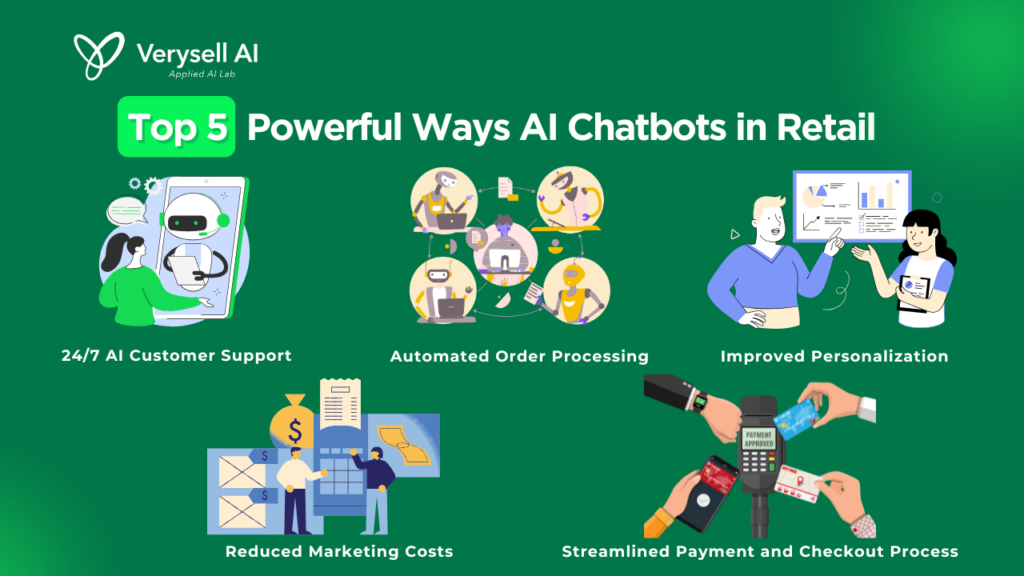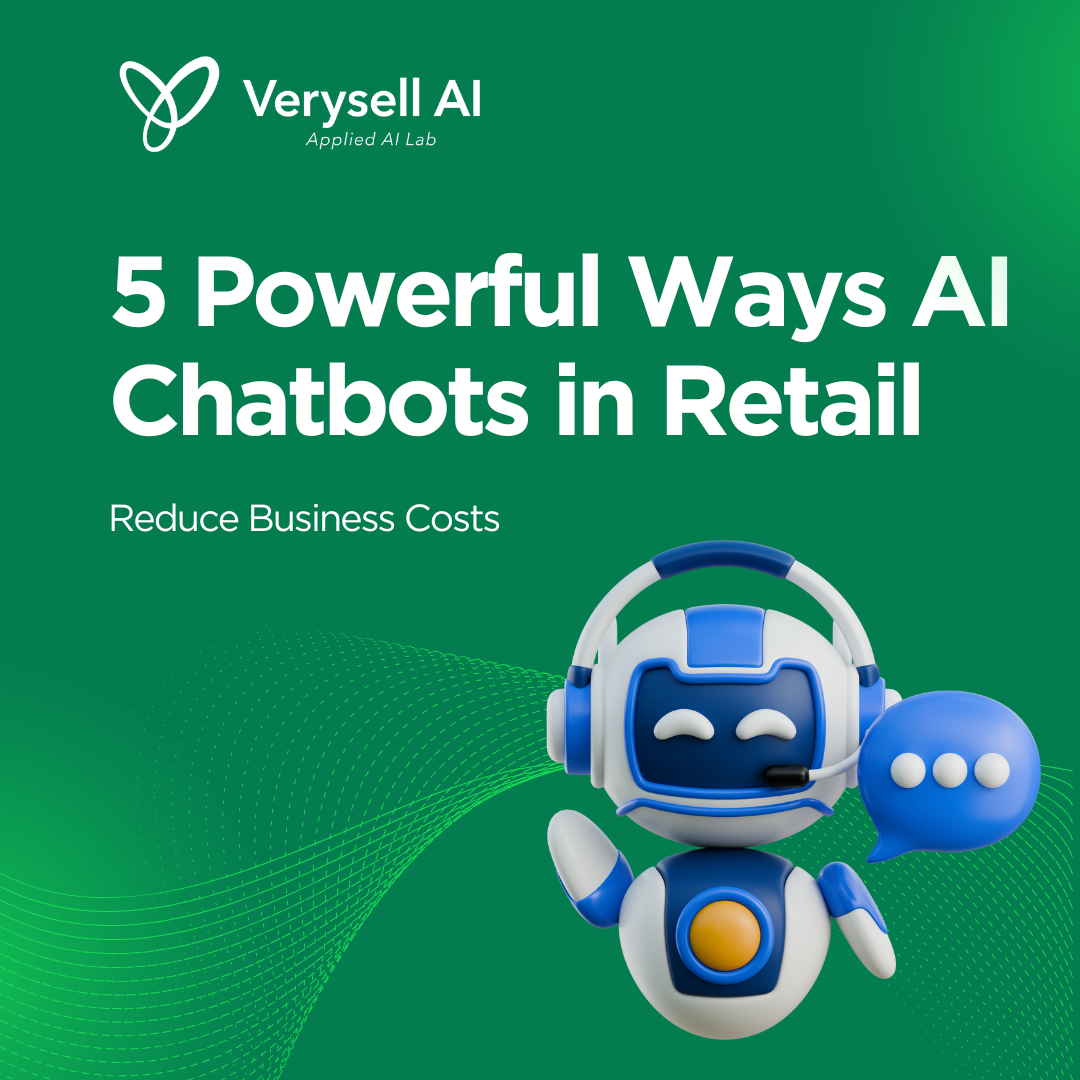AI chatbots in retail have become a game-changer, transforming how companies communicate with clients and run their operations. These chatbots use cutting-edge AI to automate monotonous chores, improve customer service, and offer 24/7 support to retailers. AI chatbots not only improve the entire customer experience but also encourage cost-cutting and efficiency improvements that support a more lucrative business model as businesses embrace digital transformation more and more. In this blog post, we will delve into five powerful ways AI chatbots in the retail industry reduce operational costs, all while enhancing the customer experience.

Top 5 Powerful Ways AI Chatbots in Retail
1. 24/7 AI Customer Support with Minimal Human Involvement
One of the most significant benefits of AI chatbots in retail is their ability to provide round-the-clock customer support with minimal human intervention. In traditional, retail businesses need to employ a large customer service team to handle inquiries, complaints, and product-related questions, especially during peak hours or after regular business hours. This can be costly, as it involves labor, overtime pay, and training.

While using AI chatbots can respond inquiries anytime (day or night), ensuring that customers can access the answer and support when needed. By automating routine tasks, such as answering frequently asked questions or providing basic product details, chatbots free up human agents to focus on more complex tasks. This reduces the need for a large customer support team, leading to substantial savings in payroll and training costs (Jobanputra, 2024).
>> Read more: AI-driven chatbots in personalized banking
2. Automated Order Processing and Inventory Management
AI chatbots in retail can integrate with other business systems for demand forecasting and inventory management. The top roles of AI chatbots in demand forecasting can be listed as real-time data collection. AI chatbots gather real-time data from customer interactions, including inquiries, feedback, and purchasing behavior, which can be used to refine demand forecasts. They also can aggregate data from various sources, such as social media and market trends, to provide additional insights into demand patterns.
For the order processing workflow, there are five stages: order placement, pick inventory, sorting, packing and shipping (Jenkins, 2021). Firstly, for order placement, customers place their orders through various channels, which are then logged into the system. Secondly, pick inventory shows the system generates a picking list, guiding staff to retrieve the necessary items from the warehouse. Then, retrieved items are sorted based on destination, ensuring that orders are organized and ready for packing. After sorting, sorted items are carefully packed to prevent damage during transit, and shipping labels are generated. Finally, packed orders are dispatched to customers, with tracking information provided for transparency.

Additionally, AI chatbots can integrate with supply chain management systems to synchronize demand forecasts with inventory levels, production schedules, and procurement plans. It also can help retailers optimize their inventory by analyzing purchasing trends and providing insights into which products are selling well. This helps businesses make more informed decisions about restocking and reduces waste or overstocking, ultimately lowering operational costs (Sukharevsky et al., 2024).
>> Read more: Top predictive analysis in retail market
3. Improved Personalization and Customer Engagement
Customer engagement is a key factor in driving sales, and AI chatbots excel at personalizing interactions with customers. By analyzing customer data and previous interactions, chatbots can provide tailored recommendations, promotions, and responses, enhancing the overall shopping experience. This personalized approach helps to build customer loyalty, increase conversions, and boost repeat business.

Chatbots can handle large volumes of interactions simultaneously when businesses save around 30% on customer support costs and 59% of them want customers to get answers more quickly (Connell, 2025). By ensuring that each customer feels valued and attended to, businesses can improve customer retention without the need for a large customer service staff, thus reducing operational costs in the long run.
4. Reduced Marketing Costs through Chatbot-Driven
Marketing can be one of the largest expenses for retail businesses. Traditionally, marketing campaigns require a significant budget for content creation, digital ads, and targeted promotions. AI chatbots can help reduce these costs by automating certain aspects of marketing campaigns, such as sending personalized messages, promotions, or product recommendations to customers based on their preferences and browsing behavior. AI chatbots are an essential tool for marketing and sales teams since they facilitate communication and increase conversions (Maxsource, 2025).

5. Streamlined Payment and Checkout Process
AI chatbots can also play a crucial role in streamlining the payment and checkout process, which is a critical part of the retail experience. By integrating payment gateways into the chatbot interface, customers can complete their purchases directly through the chatbot, reducing friction and making the entire process faster and more convenient. This automation reduces the likelihood of cart abandonment and increases conversion rates. Additionally, by automating payment processing, chatbots can reduce the need for human involvement in the checkout process, leading to a more efficient operation. This results in lower transaction handling costs and a smoother, more scalable business model.

Limitations of Chatbots
1. Lack of emotional intelligence
Even though having AI’s advances chatbots still lack emotional intelligence, which can make it difficult for them to conduct delicate or complex discussions. For instance, chatbots frequently don’t understand or offer the same amount of comfort to a consumer who is angry or frustrated as a human agent could. Customer discontent may result from this lack of emotional depth, especially in situations when understanding and empathy are essential, such managing delicate subjects or complaints.
2. Dependency on predefined scripts
When it comes to answering complicated or unexpected questions, rule-based chatbots—which function by using prewritten scripts and keyword matching—have serious limits. These bots struggle with context or ambiguity and can only react to the settings for which they were trained. Because of this, companies that depend on rule-based chatbots can discover that they are unable to respond to clients in a way that is accurate or beneficial outside of straightforward, pre-written exchanges.
Conclusion
AI chatbots in retail industry are not just a customer service tool—they are a powerful means of reducing operational costs and enhancing overall business efficiency. From providing 24/7 customer support to automating order processing, inventory management, and marketing campaigns, AI chatbots help retailers streamline operations and cut unnecessary expenses. As the retail landscape continues to evolve, businesses that embrace AI technology will find themselves better positioned to thrive in an increasingly competitive market. By integrating AI chatbots, retailers can achieve significant cost reductions while offering customers a more seamless and personalized experience


